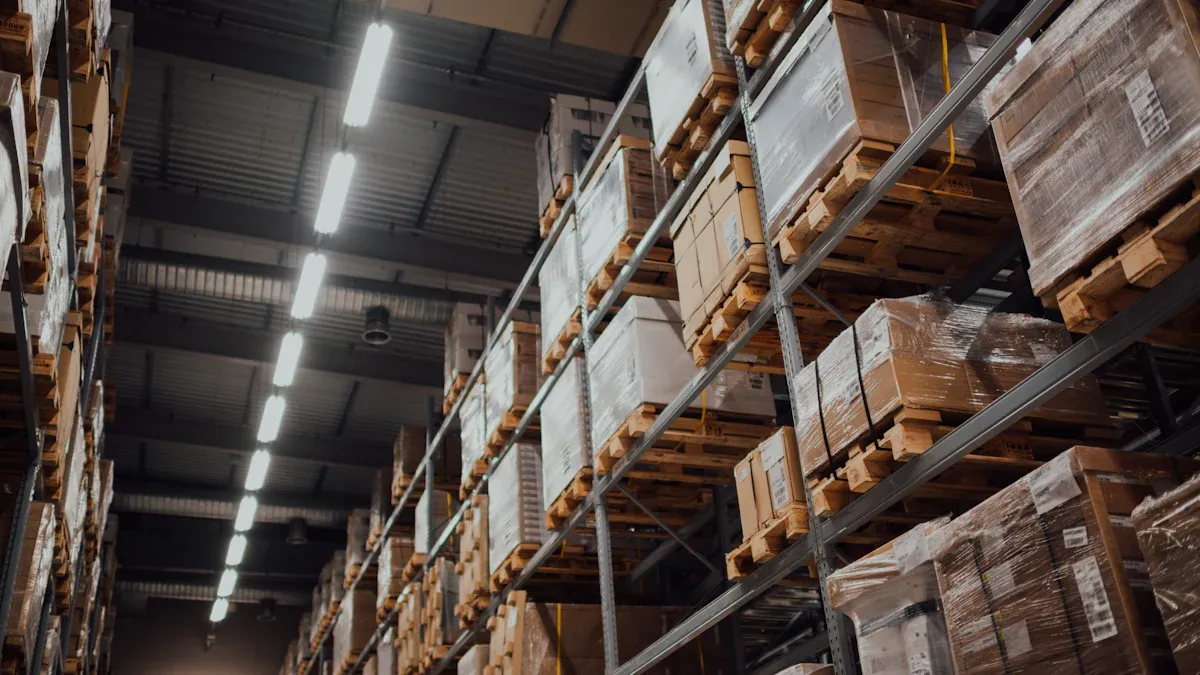Flexible Storage Solutions: How Long Can Your Goods Stay Safe in a Warehouse?

You might ask how long your goods can stay safe in a warehouse. The answer depends on what you need. Some people only need storage for a few days. Others want to store things for months or even years. How long your goods stay safe depends on three main things. Good facilities keep your items safe from weather and damage. Good security keeps your items safe from being stolen. Flexible service lets you change how long you store your items. Flexible storage solutions, like Fishgoo, give you choices for short or long storage. Fishgoo helps international buyers with storage that fits their schedule and product type. Think about how long you need to store your goods. Pick a storage partner that cares about safety and flexibility.
Factor | Impact on Safe Storage Duration |
|---|---|
Facility Quality | Good facilities help keep items safe for longer. |
Security | Better security lets you store items safely for more time. |
Service Flexibility | Flexible contracts help keep goods safe for as long as you need. |
Key Takeaways
Pick a storage place with good security. This keeps your goods safe from theft and harm.
Think about climate control for items like food and electronics. This stops them from getting ruined or spoiled.
Flexible storage lets you change space and time as you need. You can adjust when your needs change.
Packing your goods the right way keeps them safe. It stops them from getting damaged in storage or moving.
Talk clearly with your storage provider. This helps you avoid confusion and keeps your items safe.
Storage Duration Factors
Security Measures
You want your goods to be safe the whole time. Warehouses use many ways to protect your things. These ways help stop theft, damage, and loss. When you pick a storage place, check for these safety steps:
Cameras and sensors that watch for trouble
Guards who walk around to check things
Alarms that warn workers if something is wrong
Smart cameras that find real dangers
Systems that let only certain people inside
Many storage places use ID cards, keypads, or fingerprint scanners to control who gets in. Staff get training and checks happen often to keep things safe. Better cameras and tracking tools help watch your goods and lower the chance of loss. These steps help keep your things safe as long as you need.
Tip: Always ask about safety before you pick a warehouse. Good safety means you can trust your things will be safe the whole time.
Climate Control
Climate control is important for keeping your goods in good shape. These units keep the air and temperature steady. This stops your things from getting too hot, cold, or wet. Many warehouses now have climate control to help you store special items longer.
Temperature control keeps products fresh and good.
Climate control protects your things from sudden weather.
Even things that do not spoil can get ruined by heat or wet air.
Most storage places now have climate control for short or long storage. This is needed for food, medicine, and electronics. Keeping the air and temperature right helps your things last longer and stay safe.
Goods Type
The kind of goods you store changes how long they stay safe. Some things need special care. Others are fine with basic storage. Here is a table that shows what some goods need:
Category of Goods | Typical Storage Requirements |
|---|---|
Perishable Goods | Climate-controlled storage to keep temperature and humidity right. |
Pharmaceuticals | Climate-controlled storage to prevent spoilage and ensure safety. |
Electronics | Climate-controlled storage to protect sensitive equipment. |
Construction Materials | Bulk storage in open areas without shelving. |
Furniture | Bulk storage in open areas without shelving. |
Small Items (e-commerce) | Shelving systems for quick access and organization. |
Some goods, like medicine and food, need climate control to stay safe the whole time. Electronics also need climate control to stop damage. Construction materials and furniture can last longer in normal storage, but you still want them safe. Always pick a storage plan that fits your goods for the best results.
Note: If you store special goods, pick a warehouse with climate control and good safety. This helps keep your things safe for any amount of time.
Flexible Storage Solutions
Flexible storage solutions let you change your space as needed. You pick how much space you want. You also choose how long to keep your goods safe. This helps international buyers and businesses. Your needs can change fast. You do not need to sign long contracts. You do not pay for space you do not use. You can make your storage bigger or smaller when you need.
Here is a table that shows what makes storage flexible:
Characteristic | Description |
|---|---|
Adaptability | You can change your plan when your needs change. |
Flexibility | You do not sign long leases and only pay for what you use. |
On-demand access | You get space when you need it, which saves money and time. |
Fishgoo gives you cross-border warehousing, package consolidation, and quality checks. You can buy from many sellers. Fishgoo will collect your packages in one place. This saves you money and makes shipping easier. Fishgoo also gives you strong packaging, tracking, and fast order fulfillment. You get updates on your goods. You always know where your items are.
Short-Term Storage
Short-term storage is good if you need to store goods for weeks or months. This type of storage lets you get your items quickly. Many businesses use short-term storage for seasonal surges, extra stock, or new products. You can also use it for just-in-time manufacturing. This means you keep parts close to your factory.
Seasonal surges
Extra stock
Temporary product launches
Just-in-time manufacturing
Short-term storage helps you handle changes in demand. You do not need long commitments. You can move your goods in and out when you want.
Long Term Storage
Long term storage is best if you need to keep goods safe for months or years. You may use long term storage for extra stock, saving items for future sales, or storing products during long trips. Long term storage keeps your goods safe from damage and theft. Many warehouses have climate control to protect your items.
Long term storage helps you avoid losing products. You can use inventory rotation like FIFO or LIFO. This means older items get used first. Good demand forecasting helps you keep the right amount of stock.
Strategy | Description |
|---|---|
Improve Demand Forecasting | Use sales history and trends to match your stock with demand. |
Apply Inventory Rotation (FIFO/LIFO) | Move older stock first to lower the risk of aging or expired goods. |
Long term storage gives you peace of mind. You know your goods are safe and ready when you need them. Fishgoo supports both short-term and long term storage. You can pick what fits your needs best.
Maximizing Storage Safety

Packing Best Practices
You can keep your goods safe by packing them well. Good packing stops damage, dust, and moisture. Always pick the right packing for your goods. Fragile things need extra care. Heavy things need strong boxes. The right packing helps your goods last longer. It also makes moving them easier.
Why It’s Inappropriate | Recommended Packaging | How it prevents damage | |
|---|---|---|---|
Corrugated cardboard boxes | Lack of anti-static properties for sensitive electronics | Anti-static foam or bubble wrap inside anti-static bags | Prevents electrostatic discharge, protecting sensitive components |
Polyethylene bags | Not sturdy or protective enough for heavy items | Heavy-duty polyethylene or polypropylene containers | Offers greater strength and protection for heavy items |
Shrink wrap | Inadequate cushioning for fragile items | Bubble wrap or foam wrap | Provides cushioning and shock absorption for fragile items |
Use strong tape and clear labels on your boxes. This helps you find things fast later. Packing your goods well lowers the risk of damage. It also keeps your things safe during storage and shipping.
Inventory Management
Good inventory management keeps your storage safe and neat. Real-time tracking gives you instant info about your goods. This helps you make smart choices and avoid mistakes. Many warehouses use barcode scanners and software to track items. These tools help you find things fast and make fewer errors.
Key Features | |
|---|---|
Standalone Inventory Management Software | Item-level tracking with barcodes or RFID, basic reporting, easy integration with scanners |
Warehouse Management Systems (WMS) | Location-level tracking, support for multiple warehouses, labor management, shipping integration |
ERP-Integrated Inventory Modules | Connects with purchasing, finance, and sales for full business control |
ASRS-Based Inventory Tracking | Tracks every item in real time, reduces picking errors, easy software integration |
You can use just-in-time inventory to match storage with demand. This saves space and keeps goods fresh. Staff should get safety training and use protective gear. These steps make storage better and safer. You will have fewer problems and stronger protection.
Tip: Real-time tracking makes your storage more accurate. It helps you lose fewer items and keeps your goods safe.
Common Storage Mistakes
Mistakes in storage can cause broken goods and lost money. Customers may get upset if things go wrong. You can stop many problems by learning about common mistakes.
Poor Packaging
Bad packaging is a big reason goods get ruined in storage. If you use weak boxes, your items can break or spoil. Skipping inside protection can also lead to theft. About 30% of food is lost or wasted because of bad packaging. Damaged goods hurt your business and make customers lose trust. You might pay more for handling and your team will have extra work.
To stop these problems, do these things:
Pick the right material for your product’s weight and how easy it breaks.
Think about the weather and use heat-resistant coatings if needed.
Add foam or dividers inside for fragile items.
Use packaging that fits your product so it does not move.
Put your brand on the packaging for a better customer experience.
Tip: Good packaging keeps your goods safe while they are stored and shipped.
Ignoring Storage Duration
You need to plan how long your goods will stay in storage. If you forget about storage time, you might keep too much stock or hold items too long. Crowded warehouses waste space and make it hard to find things. This can cause broken goods and lost sales. Not having clear rules or skipping safety steps can also cause accidents.
Common mistakes are:
Keeping too much stock
Not rotating items
Skipping safety steps
You should track your stock and set clear rules for how long items stay. This helps you avoid waste and keeps your goods in good shape.
Lack of Communication
Not talking with your warehouse team can cause big problems. If you do not talk often, you may not know what you really have. This can cause delays, wrong orders, or running out of stock. Misunderstandings about orders and unclear rules can make storage less safe and less smooth.
Good team talk helps everyone stay safe and work better. Using walkie-talkies and having meetings can help a lot. Good communication also means you follow safety rules and act fast in emergencies.
Note: When you talk with your storage team often, you avoid mistakes and keep your goods safe.
You can keep your goods safe in a warehouse for weeks, months, or even years with the right storage plan. Flexible storage solutions help you adjust as your needs change. When you choose a reliable partner like Fishgoo, you get safe storage, easy package handling, and strong support. Start by reviewing your storage needs. Reach out to trusted providers to find the best solution for your goods.
Remember: Good planning and the right storage partner keep your items safe.
FAQ
How long can you store goods in a warehouse?
You can keep goods in a warehouse for a short or long time. It could be just a few days, many months, or even years. The time depends on what you need, what you are storing, and the warehouse’s rules. Always ask your storage provider about their time limits.
What happens if you need more storage time?
You can usually get more time if you need it. Talk to your warehouse provider before your time runs out. Many flexible storage solutions, like Fishgoo, let you change your plan if your needs change.
Can you access your goods while they are in storage?
Most warehouses let you get your goods during business hours. You might need to plan your visit or tell them before you come. Always check with your provider about their rules for access.
What types of goods need climate-controlled storage?
You should use climate-controlled storage for food, medicine, electronics, and art. These things can get ruined by heat, cold, or wet air. Climate control keeps them safe and in good shape.
How does package consolidation help you save money?
Package consolidation puts many orders into one shipment. This lowers shipping costs and makes delivery easier. You pay less for shipping and get all your goods in one package.
See Also
Understanding Warehouse Services And Their Functionality
The Importance Of International Warehouse Services For Businesses
Reliable Shipping Solutions By FISHGOO For Weidian Deliveries
Enhancing Cross-Border E-Commerce Logistics For Global Growth


